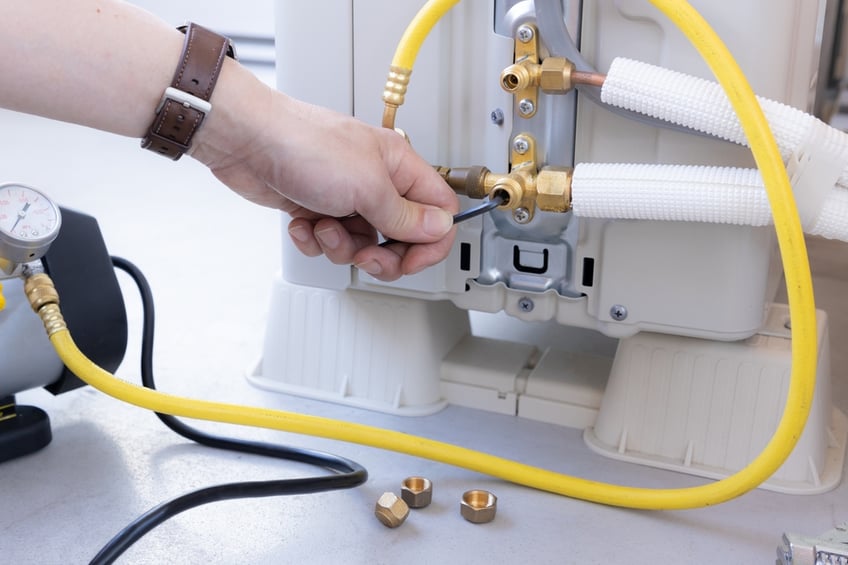Updated Efficiency Ratings for HVAC Equipment: SEER2, EER2 and HSPF2

The US Department of Energy updated the testing procedure for central air conditioners and heat pumps in January 2023. This results in new HVAC efficiency ratings:
- Seasonal Energy Efficiency Ratio 2 (SEER2)
- Energy Efficiency Ratio 2 (EER2)
- Heating Seasonal Performance Factor 2 (HSPF2)
The meaning of these efficiency ratings remains the same, but the testing procedure through which they are determined has been modified. The new procedure is more stringent, which means the new SEER2 / EER2 / HSPF2 ratings for a given piece of equipment are lower than its original SEER / EER / HSPF values.
Get a professional HVAC design for your next building project.
As you might guess, the ENERGY STAR Certification requirements for central air conditioners and heat pumps have also changed. The US EPA has updated their key product criteria with the new SEER2 / EER2 / HSPF2 ratings.
The New HVAC Testing Procedure for SEER2, EER2 and HSPF2

The original efficiency testing procedure for HVAC equipment used a static pressure of 0.1 in of water. However, the US Department of Energy concluded that this test pressure did not reflect the actual field conditions to which HVAC systems are exposed. The performance of air conditioners and heat pumps is affected by external static pressure sources, such as ductwork.
- The M1 testing procedure compensates for the performance impact of real-world conditions, increasing the static pressure by a factor of five.
- In other words, HVAC equipment is now tested at 0.5 in of water (up from 0.1 in).
The performance of HVAC equipment changes under the new testing conditions, and this results in different efficiency values. The new SEER2, EER2 and HSPF2 nomenclature is used to specify efficiency ratings determined with the new M1 testing procedure, while the original nomenclature is used for efficiency ratings determined with the old procedure.
Assuming you test the same heat pump under both procedures, the SEER2/EER2/HSPF2 values will be lower, since the M1 test is more demanding (static pressure is five times higher).
Updated Energy Efficiency Requirements for HVAC Equipment Sold in the US
The Department of Energy has published new efficiency requirements for HVAC equipment in the US, and states are divided into three regions: North, Southwest and Southeast. The following tables break down the new requirements for each region.
The US DOE also published updated efficiency requirements for HVAC equipment under the previous standard (SEER/EER/HSPF). Most of the equipment on inventory can still be sold with one major exception: air conditioners that only meet the old efficiency requirements can no longer be installed in southern states.
2023 HVAC Efficiency Requirements - US North
|
Equipment Type |
Minimum Energy Efficiency |
|
Air conditioner, split system |
13.4 SEER2 (or 14.0 SEER) |
|
Heat pump, split system |
14.3 SEER2 (or 15.0 SEER) 7.5 HSPF2 (or 8.8 HSPF) |
|
All packaged systems: air conditioners, heat pumps, gas-electric combo |
13.4 SEER2 (or 14.0 SEER) 6.7 HSPF2 (of 8.0 HSPF) |
13.0 SEER air conditioners and 14.0 SEER heat pumps compliant with the old efficiency requirements can still be sold if they were manufactured before January 1, 2023.
2023 HVAC Efficiency Requirements - US Southwest
|
Equipment Type |
Minimum Energy Efficiency |
|
Air conditioner, split system, below 45,000 BTU/h |
14.3 SEER2 (or 15.0 SEER) 11.7 EER2 (or 12.2 EER) |
|
Air conditioner, split system, 45,000 BTU/h or larger |
13.8 SEER2 (or 14.5 SEER) 11.2 EER2 (or 11.7 EER) |
|
Heat pump, split system |
14.3 SEER2 (or 15.0 SEER) 7.5 HSPF2 (or 8.8 HSPF) |
|
All packaged systems: air conditioners, heat pumps, gas-electric combo |
13.4 SEER2 (or 14.0 SEER) 6.7 HSPF2 (of 8.0 HSPF) |
14.0 SEER heat pumps compliant with the old requirements can still be sold if they were manufactured before January 1, 2023. Air conditioners can only be sold if they meet the updated requirements.
2023 HVAC Efficiency Requirements - US Southeast
|
Equipment Type |
Minimum Energy Efficiency |
|
Air conditioner, split system, below 45,000 BTU/h |
14.3 SEER2 (or 15.0 SEER) |
|
Air conditioner, split system, 45,000 BTU/h or larger |
13.8 SEER2 (or 14.5 SEER) |
|
Heat pump, split system |
14.3 SEER2 (or 15.0 SEER) 7.5 HSPF2 (or 8.8 HSPF) |
|
All packaged systems: air conditioners, heat pumps, gas-electric combo |
13.4 SEER2 (or 14.0 SEER) 6.7 HSPF2 (of 8.0 HSPF) |
14.0 SEER heat pumps can still be sold if they were manufactured before January 1, 2023, but air conditioners can only be sold if they meet the updated requirements.

Michael Tobias
Michael Tobias, the Founding Principal of NY Engineers, currently leads a team of 150+ MEP/FP engineers and has led over 4,000 projects in the US
Join 15,000+ Fellow Architects and Contractors
Get expert engineering tips straight to your inbox. Subscribe to the NY Engineers Blog below.

